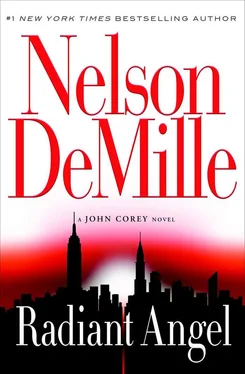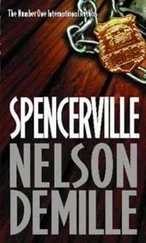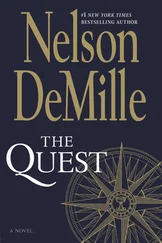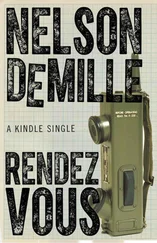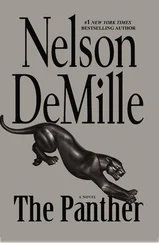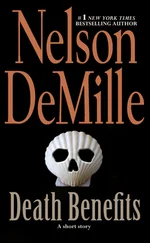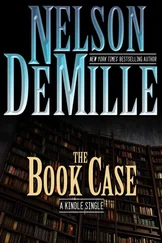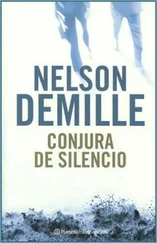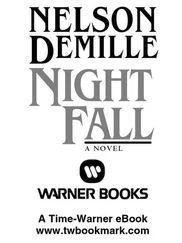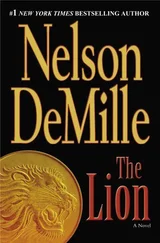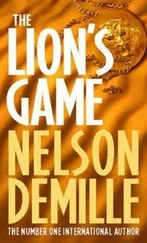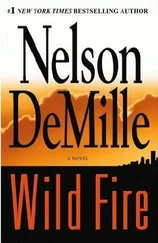But when you get tons of negative information, that causes a false sense of security, not to mention a comfortable sense of denial.
There’s not a lot to do in a small ship’s cabin while you’re standing around waiting for a nuclear explosion — or hopefully an alert that the target has been spotted — so Conte and Andersson played with their electronics, monitored their instruments, and pulled up New York Harbor on Google Earth. Tess scanned the water and shorelines with binoculars, and I stared out at the Manhattan skyline, and the Statue of Liberty, and the Twin Beams. Now and then Tess, Conte, or Andersson would offer some theories about the whereabouts of The Hana .
The possibilities were reduced to four: Petrov had long ago aborted the mission and The Hana was on its way across the Atlantic. Or two, it was under the Atlantic, scuttled. Three, there never was a mission or a nuke, and Petrov was aboard The Hana having a party with the prince and the prostitutes, probably off the coast of Atlantic City. The fourth possibility was that The Hana with Petrov and the nuke had found a good place to hide, either in the harbor or out on the ocean, and we would be seeing the yacht and/or the fireball very soon.
Conte pointed out, “We’re not contributing much to the operation.”
I replied, “We don’t know that yet.”
Conte shrugged, then smiled and said, “Hey, I’ve never seen a nuke detonate. I can tell my grandkids about it someday.”
Cops, as I said, have a sick sense of humor.
So we waited.
At 4:15 A.M. Nikola Andersson informed us, “We now have a low-fuel situation.”
I asked, “How long can we idle?”
Andersson replied, “Maybe... fifteen minutes. Then we need to head out.” She added, “We have a five-gallon gas can onboard.”
“Kill one engine,” I suggested.
Conte said, “I’ll kill both. We’ll drift out with the tide, then restart if we get an alert.”
He shut down both engines, and the night became very quiet, except for the sound of helicopters overhead.
We began to drift south, away from Manhattan Island.
Conte said, “We’re doing maybe three or four knots, so it will take over an hour to reach The Narrows.”
Well, we were still in the game, but backing out slowly — though with enough fuel to charge back in if we got the word.
The cabin was getting claustrophobic, so I exited and climbed along the gunnel onto the bow. Ms. Faraday decided to join me, and we sat cross-legged on the foredeck. Behind us the skyline of Manhattan was retreating, and ahead, about five or six miles away, I could see the lights of the Verrazano Narrows Bridge on the horizon. The old fort on Governors Island was passing by on our left, which reminded me that the entire harbor and the entrance to the harbor were covered with radiation detectors and none of them had lit up, and none of them would if I was right about the nuke being submerged in The Hana ’s flooded garage. And if everything went wrong tonight, this place would be radioactive for two or three decades.
Tess asked, “What do you think?”
“About?”
“The Hana. Petrov.” She asked, “Did we get this wrong?”
“I hope so. But I don’t think so.”
“Then where is he? How do you hide a two-hundred-foot ship?”
I looked at the long piers sticking out from the coastline of Brooklyn. I knew there were about forty or fifty of them, some abandoned and derelict, and some hidden in basins that were formed by breakwaters.
The New Jersey waterfront was also lined with piers, active and inactive, over a hundred of them, running from Bayonne near The Narrows up the Hudson River for about fifteen miles.
There was lots of revitalization construction along the shorelines that made up the Port of New York, so there were lots of places for a two-hundred-foot yacht to hide along the waterfront on a dark, foggy night. And even with an air, sea, and land search of this size and intensity, there was so much ground clutter on the radar screen that a stationary ship along the waterfront might well go undetected. Plus, the harbor itself was huge — maybe close to thirty square miles.
I never met Vasily Petrov, but I felt, after watching him for months, that I could get into his head. And if I were Vasily Petrov, I would have made a high-speed run to the goal line before anyone else knew there was a game in progress. I said to Tess, “He’s here. In the harbor.”
She wasn’t so sure and said, “What I think is that The Hana is out on the ocean, electronically silent, ready to make its run through The Narrows.” She added, “I remember you said it would be difficult to stop a big ship that was going full speed ahead from entering the harbor.”
I didn’t reply.
She continued, “Assuming Petrov is prepared to give his life to accomplish this mission, all he has to do is plow through those security vessels around the bridge, and he’s in the harbor. Then he keeps going full speed ahead and within... what did you say? In less than twenty minutes The Hana is at the tip of Manhattan.” She added, “There are not many security vessels inside the harbor.”
“Correct. But the vessels at The Narrows will pursue and carry out a boarding.”
“I’m sure Petrov has the ability to detonate the nuke anytime.”
“Right.”
She stayed silent, then asked, “So why are we here?”
I hate when people ask questions like that.
“John?”
“We are here to let Petrov know we are here. We are here to force his hand and make him detonate the nuke prematurely, before he gets close to Manhattan. We are here to remove any thought he has of escaping the blast or escaping a bullet.” I added, “But mostly we and everyone else are here because this is our job.”
“And maybe we’re here to pray.”
So we sat there on the bow of the SAFE boat, knowing that any second could be our last. Well, there are worse ways to make an exit.
Tess was looking up at the sky, which was clear and starlit. The moon was low on the western horizon and moonlight sparkled on the bay.
In fact, it was a nice night. The harbor was calm, the shore lights reflected on the water, and the misty fog was... well, romantic.
Tess took my hand.
Neither of us spoke for awhile, then she said, “Will you buy me a drink tonight?”
“Of course.”
“You can bring your wife if you’d like.”
“And you can bring Grant.”
She laughed softly, then said, “If you bring Kate, I’ll bring Buck.”
“Is that a threat?”
She squeezed my hand. “I’m frightened.”
“We’re all frightened. It’s okay.”
“What’s your favorite bar?”
“All of them.”
“I’ll take you to the Yale Club if you promise to behave.”
“I’ll take you to a Russian nightclub in Brighton Beach if you promise not to behave.”
“It’s a date.”
She put her arm around me and I did the same. I could only imagine what Pete and Nikola were thinking.
Well... what difference did it make at this point?
Conte opened the front window of the cabin and said, “I hate to interrupt, but for what it’s worth, a helicopter just got a radar blip moving on the water near the Thirtieth Street Pier... but no radiation. So maybe it’s an outbound cargo ship.”
I knew the Thirtieth Street Pier, because the NYPD had once used that Brooklyn pier to store vehicles that had been towed, abandoned, or stolen and recovered. But now it was being converted into a modern recycling facility — so there shouldn’t be any ships using the pier.
Last time I saw this facility, a huge steel boathouse bigger than three football fields was being constructed to enclose the pier. On the land side of the project was construction equipment and material, surrounded by a twelve-foot chain-link security fence. It occurred to me that an NYPD patrol car checking out the waterfront could not possibly see the far end of the enclosed pier, which was nearly three hundred yards from the fence. And it was very possible that an NYPD Harbor vessel, even with a searchlight, might not see a ship sitting inside the huge, unlit enclosure, especially if construction barges were moored at the end of the pier. To add to all this, the roof of the steel structure was covered with photoelectric cells that would confuse any helicopter’s infrared devices or penetrating radar. Maybe I should have thought of this sooner.
Читать дальше
